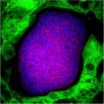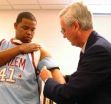(Press-News.org) Satellite images from two NASA satellites were combined to create a full picture of Tropical Storm Leslie and Hurricane Michael spinning in the Atlantic Ocean. Imagery from NASA's Aqua and Terra satellites showed Leslie now past Bermuda and Michael in the north central Atlantic, and Leslie is much larger than the smaller, more powerful Michael.
Images of each storm were taken by the Moderate Resolution Imaging Spectroradiometer, or MODIS instrument that flies onboard both the Aqua and Terra satellites. Both satellites captured images of both storms on Sept. 7 and Sept. 10. The image from Sept. 7 showed a much more compact Michael with a visible eye. By Sept. 10, the eye was no longer visible in Michael and the storm appeared more elongated from south to north.
Leslie Moves Past Bermuda Heads to North Atlantic
On Sept. 8 at 5 p.m. Leslie was a tropical storm with maximum sustained winds near 55 knots. It was about 240 miles (390 km) south-southeast of Bermuda near 29.4 North latitude and 62.5 West longitude. Leslie was moving north and expected to pass to the east of or close to Bermuda later in the day. A tropical storm warning was in force for Bermuda on Sept. 8 and 9, and forecasters at the National Hurricane Center expected rainfall totals of 1 to 2 inches in Bermuda.
By Sept. 9 at 5 p.m. EDT, Leslie had passed to the east of Bermuda and was centered about 175 miles (280 km) east-northeast of the island, near 33.4 North and 61.2 East. Leslie's maximum sustained winds were near 60 mph (95 kmh) as it continued moving to the north at 14 mph (22 kmh).
By Monday, Sept. 10, Leslie had moved north of Bermuda and was about 805 miles (1,300 km) south-southwest of Cape Race, Newfoundland, Canada, near 36.5 North latitude and 60.8 West longitude. Leslie was moving to the north-northeast at 18 mph (30 kmh) and had maximum sustained winds near 60 mph (95 kmh).
MODIS satellite data shows that Leslie has one main band of powerful thunderstorms and heavy rainfall, located to the northeast quadrant of the storm.
Watches have now been posted for Newfoundland, Canada as Leslie tracks northward. A hurricane watch is now in effect in Newfoundland, from Stones Cove to Charlottetown. A hurricane watch means that hurricane conditions are possible within the watch area, in this case within 24 to 36 hours, according to the National Hurricane Center.
In addition, a tropical storm watch is in effect for Newfoundland, from Indian Harbor to Stones Cove and from Fogo Island to Charlottetown.
Monday, Sept. 10 is expected to be Leslie's last day in warm waters and low-wind shear. After today the storm is forecast to move into cooler waters and the wind shear is expected to kick up. Those are two factors that weaken a tropical cyclone. Leslie is expected to start transitioning from a warm core system to a cold core system later on Sept. 10, which means the storm will be undergoing a change into an extra-tropical storm.
Michael, Once "Wide-Eyed," Now Weakening from Atmosphere and Ocean
Hurricane Michael experienced some adjustments in "vision" over the weekend when the storm's eye grew wider. On Sept. 8, Michael was still a hurricane with maximum sustained winds near 90 knots (150 kmh). Michael was located near 33.1 North latitude and 42.3 West longitude, about 925 miles (1,485 km) west-southwest of the Azores. Michael's tropical-storm-force wind field was about 70 miles (110 km) out from the center, making the storm about 140 miles (220 km) in diameter. Michael was weakening slowly due to atmospheric conditions and cooler waters and by Sept. 9, Michael's maximum sustained winds were still near 90 mph (150 kmh) when it was 990 miles (1,590 km) west-southwest of the Azores islands. On Sunday, Michael's eye widened from 10 miles in diameter to 30 miles in diameter, as was seen in satellite imagery.
By Monday, Sept. 10, Michael's maximum sustained winds at 5 a.m. EDT were near 80 mph (130 kmh). Michael was centered about 1,065 miles (1,715 km) west of the Azores Islands near 33.5 North and 45.2 West. Michael was moving to the west at 7 mph (11 kmh) and is expected to turn northwestward later on Sept. 10, followed by a turn to the north and northeast. Michael could become a tropical storm by the end of the day on Sept. 10, according to the National Hurricane Center.
Another Storm Brewing in the Eastern Atlantic
Satellite imagery showed that another tropical depression may be forming in the eastern Atlantic. The low, called System 90L appears more organized on Monday, Sept. 10. It is located about 855 miles west of the Cape Verde Islands and is being carefully watched. The National Hurricane Center gives it a 90 percent chance of becoming a depression later on Sept. 1 as it moves west-northwestward at 15 to 20 mph.
INFORMATION:
To see the Sept. 10 MODIS image of Leslie and Michael, visit: http://lance-modis.eosdis.nasa.gov/cgi-bin/imagery/single.cgi?image=LeslieMichael.A2012253.1650.4km.jpg
To see the Sept. 7 MODIS image of Leslie and Michael, visit: http://lance-modis.eosdis.nasa.gov/cgi-bin/imagery/single.cgi?image=LeslieMichael.A2012251.1525.4km.jpg
NASA catches Tropical Storm Leslie and Hurricane Michael in the Atlantic
2012-09-11
ELSE PRESS RELEASES FROM THIS DATE:
'Humanized' mice developed at OHSU enable malaria research breakthrough at Seattle BioMed
2012-09-11
PORTLAND, Ore. — A novel human liver-chimeric mouse model developed at Oregon Health & Science University and Yecuris Corporation has made possible a research breakthrough at Seattle Biomedical Research Institute that will greatly accelerate studies of the most lethal forms of human malaria.
The study findings are published online in the Journal of Clinical Investigation. Study photos were selected to appear in "Scientific Show Stoppers" on the JCI blog.
Plasmodium falciparum, one of two human-specific malaria parasites, is a global health crisis, causing more than ...
Mushroom-derived compound lengthens survival in dogs with cancer, Penn Vet study finds
2012-09-11
PHILADELPHIA — Dogs with hemangiosarcoma that were treated with a compound derived from the Coriolus versicolor mushroom had the longest survival times ever reported for dogs with the disease. These promising findings offer hope that the compound may one day offer cancer patients — human and canine alike — a viable alternative or complementary treatment to traditional chemotherapies.
The study was conducted by two University of Pennsylvania School of Veterinary Medicine faculty. Dorothy Cimino Brown is professor and chair of the Department of Clinical Studies and director ...
Psychopathic boldness tied to US presidential success
2012-09-11
The fearless dominance associated with psychopathy may be an important predictor of U.S. presidential performance, suggests an analysis published this week in the Journal of Personality and Social Psychology.
"Certain psychopathic traits may be like a double-edged sword," says lead author Scott Lilienfeld, a psychologist at Emory University. "Fearless dominance, for example, may contribute to reckless criminality and violence, or to skillful leadership in the face of a crisis."
In fact, fearless dominance, linked to diminished social and physical apprehensiveness, ...
LifeSkills training helps teens manage anger, lower blood pressure
2012-09-11
AUGUSTA, Ga. – A 10-week program that fits easily into the high school curriculum could give students a lifetime of less anger and lower blood pressure, researchers report.
Health and physical education teachers taught anger and stress management to 86 ninth graders in Augusta, Ga., and found their ability to control anger increased, their anxiety decreased and their blood pressures were generally lower over the course of a day compared to 73 of their peers who received no intervention, according to a study published in the journal Translational Behavioral Medicine.
Among ...
Measuring mercury levels: Nano-velcro detects water-borne toxic metals
2012-09-11
ANN ARBOR, Mich.—A strip of glass covered in hairy nanoparticles can cheaply and conveniently measure mercury, which attacks the nervous system, and other toxic metals in fluids.
Researchers at the Swiss Federal Institute of Technology (EPFL), Northwestern University and the University of Michigan found that their new method can measure methyl mercury, the most common form of mercury pollution, at unprecedentedly small concentrations. The system, which could test for metal toxins in drinking water and fish, is reported in the current edition of Nature Materials.
Methyl ...
University of Maryland study: Neonatal heart stem cells may help mend kids' broken hearts
2012-09-11
Baltimore, MD – September 10, 2012 – Researchers at the University of Maryland School of Medicine, who are exploring novel ways to treat serious heart problems in children, have conducted the first direct comparison of the regenerative abilities of neonatal and adult-derived human cardiac stem cells. Among their findings: cardiac stem cells (CSCs) from newborns have a three-fold ability to restore heart function to nearly normal levels compared with adult CSCs. Further, in animal models of heart attack, hearts treated with neonatal stem cells pumped stronger than those ...
Expanding database enables discoveries in emerging field of metabolomics
2012-09-11
LA JOLLA, CA – September 10, 2012 – Over the last decade, metabolomics has emerged as the newest of the "omic" sciences (following genomics and proteomics) to provide comprehensive biochemical information about cellular metabolism. This new field has revealed that many of the chemicals involved in or produced through metabolism are currently unknown, but may play vital and previously unappreciated roles in human health and disease.
A major hurdle in profiling both unknown and known metabolic compounds ("metabolites") has been the scarce amount of reference data. But ...
Researchers closer to understanding actions of cells involved in atherosclerosis
2012-09-11
TORONTO, Sept. 10, 2012—Researchers at St. Michael's Hospital are one step closer to understanding why plaque bursts in coronary arteries and causes heart attacks.
The clue might be something called microRNA-145. MicroRNAs are short chains of bossy molecules that scientists are increasingly coming to realize control a wide variety of biological processes.
Dr. Subodh Verma, a cardiac surgeon at St. Michael's, published a paper in the journal Circulation today, describing for the first time how microRNA-145 gene therapy can drastically reduce the severity and progression ...
ORNL roof and attic design proves efficient in summer and winter
2012-09-11
A new kind of roof-and-attic system field-tested at the Department of Energy's Oak Ridge National Laboratory keeps homes cool in summer and prevents heat loss in winter, a multi-seasonal efficiency uncommon in roof and attic design.
The system improves efficiency using controls for radiation, convection and insulation, including a passive ventilation system that pulls air from the underbelly of the attic into an inclined air space above the roof.
"Heat that would have gone into the house is carried up and out," says Bill Miller of ORNL's Building Envelope Group. "And ...
Improved diagnostic test benefits children with acute myeloid leukemia
2012-09-11
(MEMPHIS, Tenn. – September 10, 2012) Early treatment response is a powerful predictor of long-term outcome for young patients with acute myeloid leukemia (AML). The information can help physicians decide whether a more intensive approach is needed. Research led by St. Jude Children's Research Hospital investigators has identified the best test for measuring that response and guiding therapy.
The method uses a laboratory technique called flow cytometry, which makes it possible to identify a single cancer cell in 1,000 normal cells that remain in patient bone marrow after ...


